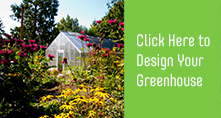It would be difficult to imagine a world without trees, plants, flowers or green lawns. As I look out my kitchen window, the ground is covered with a blanket of snow and the landscape looks barren compared to warmer months. As I step into my greenhouse, I am immediately enveloped by warmth, color and tropical plants. It truly feels magical each and every time and that is the beauty of having your own greenhouse. Read on for a little bit of history on greenhouses and plant trivia.
|
December in the Greenhouse
|
|
|
-
If you've planted bulbs in pots, examine them for signs of growth. Now is the time to bring them into the greenhouse for forced blooming.
-
It's important to keep the greenhouse air circulating to prevent diseases.
-
Care for plants and seeds to ensure that they do not dry out in between watering.
-
Begin cuttings and seed planting in the greenhouse for the upcoming spring season. |
|
History of Greenhouses |
Early Romans built greenhouse structures so that cucumbers could be grown out of season. Glass wasn't yet invented and these "Speculariums" were made with tiny sheets of translucent mica.
The first practical greenhouse was designed by Jules Charles, a French botanist and was built in Holland. Greenhouses began spreading throughout Europe. The French, who loved oranges, began building orangeries to protect their precious trees from frost. |
|
|
Greenhouses were improved structurally with angled glass walls and heating flues in the 17th century. Larger greenhouses and elaborate structures were built to please both the eye and the palates of European aristocracy. The palace of Versailles was a good example of these spectacular orangeries. The structure measured 500 feet long, 42 feet wide and 45 feet high! |
|
|
The Victorian age in England really ushered in the golden era of the greenhouse. By the end of the mid nineteenth century, glass was plentiful and the wealth began competing with each other over who could build a more elaborate greenhouse. The greenhouses were used primarily for flowers and citrus fruits. Kew Gardens in England is a prime example of the Victorian greenhouses, and there is a replica in San Francisco's Golden Gate Park called Conservatory of Flowers.
Greenhouses arrived in the U.S. by a Boston merchant in 1737. The concept spread slowly and greenhouses were once again built primarily for the wealthy. George Washington, who craved pineapples, ordered a "pinery" to be built so that he could serve pineapples to guests year round. |
| The modern greenhouses of today are simple and practical, and anyone interested in gardening can have one for relatively little cost. You can attach a greenhouse to your home or place a free standing unit in your backyard. The greenhouses of today are made with materials that will stand the test of time. |
|
Planning a Greenhouse |
|
A greenhouse allows you to pursue your passion for gardening year round, regardless of the outdoor climate. Experiment with exotic plants, fruits and fresh veggies or new plants you've never grown before. Today there are over 3 million hobby greenhouses in the U.S. and this number is expected to "grow" rapidly. |
|
|
It's important to assess your needs before you choose a greenhouse that is right for you. How big of a greenhouse do you want? You'll probably want to make it as large as space and budget allows. What will you be using the greenhouse to grow? If you are only interested in starting a small amount of seeds, perhaps a cold frame or mini greenhouse is all you need.
Most people today want a greenhouse that will complement their home, even creating a focal point in their gardens. There are many styles of greenhouses for home owners to choose from for this very reason.
Will you need a permit? Each community has different guidelines when it comes to permits, so you are best to find out from your local building code people. Usually the same guidelines apply as for sheds or small portable structures. Permits are easily obtained and generally inexpensive.mine cost me $50.00.
You will need to consider heating, cooling and watering for you greenhouse. Any form of heat can be used, and it is best to use a system that is thermostatically controlled. Southern exposure is also recommended to capitalize on solar energy. Don't worry if you have shade trees, they lose their leaves in winter anyway allowing the sun to come through.
Once you've determined what you want a greenhouse for, it is much easier to choose one that is best suited to you. If you would like to receive our color brochure and price list, please email shelley@ecolad.com
| |
|
Plant Trivia |
What plant has the longest leaf?
The Raffia Palm. Native to Africa, it produces a 13 foot stalk with a leaf that grows about 60 feet long. |
|
| What is the oldest known plant?
The Creosote Bush that grows in the Mojave Desert. It is believed to be about 11,700 years old. |
|
| What plant produces the smallest seed?
Orchids produce microscopic seeds that can float through the air unnoticed. |
|
What flower's name means to open in the day and to sleep at night?
|
|
The Daisy. The Old English is "Days Eye" as it opens in sunlight and closes at night. | |
|
| What is the largest living thing on earth?
A Giant Sequoia tree living in California measures 80 feet around and it is estimated that it could build 40 average sized homes. |
|
Can pinecones predict the weather?
|
|
A closed pinecone may be a sign that rain is just around the corner and an open pinecone tells of warm dry days. Pinecones release their seeds on warm dry days. | |
|
| What common garden flower is not really one flower at all, but made up of hundreds of tiny little flowers?
A Sunflower. It is actually composed of hundreds of tiny flowers inside what looks to be a giant flower. Each floret produces a seed.
Backyard Greenhouses
A Div. of Ecolad Corporation
1-800-665-2124
| | |
|
|
|
|
| | |
![]() Visit the News page here..
Visit the News page here..







